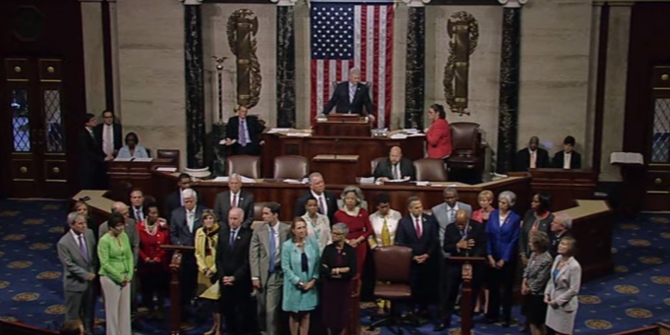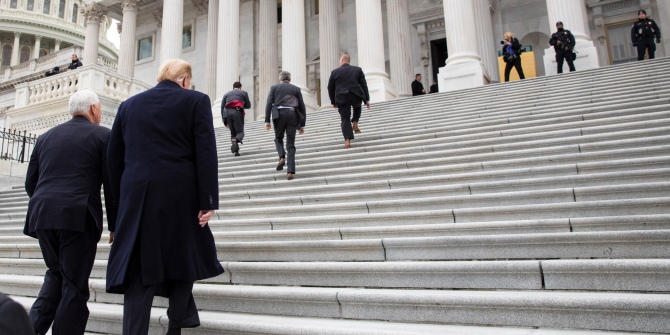 During the primary elections for the 2022 midterms few Republican candidates embraced a narrative of accepting the results of the 2020 presidential election. Mike Cowburn writes that while election denialism has become a visible split within the Republican Party, divides within the Democratic Party between those on the more progressive left and the traditional party establishment have also become more apparent since the 2016 election.
During the primary elections for the 2022 midterms few Republican candidates embraced a narrative of accepting the results of the 2020 presidential election. Mike Cowburn writes that while election denialism has become a visible split within the Republican Party, divides within the Democratic Party between those on the more progressive left and the traditional party establishment have also become more apparent since the 2016 election.
This article is part of ‘The 2024 Elections’ series curated by Peter Finn (Kingston University). Ahead of the 2024 election, this series is exploring US elections at the state and national level. If you are interested in contributing to the series, contact Peter Finn (p.finn@kingston.ac.uk).
Factional divides within both the Republican and Democratic parties have become increasingly prominent in recent years. The 2022 midterm primary elections for the House of Representatives offered insight into these internal dynamics which have continued in the early primaries of 2024.
Election denialism and Trumpian Influence
Election denialism was a central theme in Republican primaries in 2022 with candidates aligning themselves along a spectrum of acceptance or rejection of former President Donald Trump’s claims regarding the legitimacy of the 2020 presidential election. Many candidates either raised questions about the integrity of the electoral process or simply denied the result. As Figure 1 shows, few candidates embraced narratives of acceptance of the results of this election, often choosing instead not to comment or to avoid answering direct questions on the topic. Trump’s endorsements often favored candidates who espoused his narrative on election integrity, creating notable factional divides within the party’s ranks. This can be seen as a new issue following the 2020 election cycle on which the pro-Trump versus quiet-about-Trump (few primary candidates were openly hostile to the former president) divide continued into 2022.
Figure 1 – 2022 candidates and denial of 2020 presidential election result

Election denialism as a fracture within the party was particularly visible in high-profile races, such as those involving Republican incumbents who had voted for Trump’s impeachment. In these contests, challengers who embraced Trump’s narrative and often received his endorsement posed formidable challenges to incumbent lawmakers who had accepted the election’s outcome, highlighting the deep-seated divisions within the Republican Party. Of the ten Republicans who voted for impeachment, six ran again in 2022:
- Elizabeth Cheney of Wyoming (fully accepted), lost to Trump-endorsed Harriet Hageman (fully denied)
- Jaime Herrera Beutler of Washington (fully accepted), lost to Trump-endorsed Joe Kent (fully denied). Kent went on to lose in the general election.
- Peter Meijer of Michigan (fully accepted), lost to Trump-endorsed John Gibbs (raised questions).
- Dan Newhouse of Washington (fully accepted), won against three fully denied candidates, including Trump-endorsed Loren Culp. Election deniers may have split the vote, with Newhouse only receiving 34 percent of the Republican vote.
- Tom Rice of South Carolina (accepted with reservations), lost the primary against Trump-endorsed Russell Fry (fully denied)
- David Valadao of California (fully accepted) won primary against Chris Mathys (fully denied), no Trump endorsement.
The two incumbents who survived (Newhouse and Valadao) both represented districts in states with non-partisan top-two primaries. One explanation of their success may be that Democratic voters decided to turn out and support these incumbents, though Newhouse’s race featured three election denying Republicans who may have split the vote, and Valadao’s contest was notable for taking place in a swing district only won back by Republicans in 2020, when Trump declined to endorse his election denying opponent.

“20220517-Primary-Election-MN-20” (CC BY-NC-ND 2.0) by Multnomah County Communications
Further complicating this pattern was Democratic involvement in Republican primaries in support of election deniers and far-right candidates that they perceived to be weaker and thus easier to defeat in the November general election. This approach also raised legitimate concerns about the long-term implications for democratic norms and the integrity of the electoral process, prompting further calls from some quarters for primary election reform.
The role of election denialism does not appear to be lessening in the 2024 cycle. In West Virginia’s 1st District, January 6th rioter Derrick Evans lost to incumbent Representative Carol Miller. Evans attempted to fundraise on the back of his conviction, starting “I did time in prison for Trump”. The addition of election denialism and views of January 6th can therefore be understood as a new expression of an existing Trumpian cleavage within the party.
Progressives vs. “Establishment” Democrats
The Democratic Party has long been thought of as containing a more progressive or leftist faction that competes with the party establishment. This cleavage has been particularly prominent in Democratic primaries since 2016.
In recent research, I coded the factional affiliation of Democratic primary candidates, identifying that more than half of contested races took place between a candidate clearly aligned with the progressive faction against an establishment alternative (108 of 208, 51.6 percent). This trend is broadly consistent with recent historical patterns, shown elsewhere, with these challenges becoming more prevalent since 2016, likely connected to Vermont Senator Bernie Sanders’ first presidential bid.
As in the Republican Party, this divide within the party is also clearly visible in several high-profile contests. In Oregon’s 5th District, incumbent Blue Dog Kurt Schrader lost in the primary to progressive Jamie McLeod-Skinner, who received support from Elizabeth Warren. In Texas’s 28th District, incumbent Henry Cuellar (who was recently indicted on federal bribery charges) narrowly held off progressive challenger Jessica Cisneros. These races do appear somewhat different than the initial waves of progressive challenges in 2018, which largely focused on safe Democratic districts, such as those now represented by Alexandria Ocasio-Cortez (NY-14, D+29 in 2018), Rashida Tlaib (MI-12, D+32), Ilhan Omar (MN-05, D+26), and Ayanna Pressley (MA-07, D+34). In future cycles, these high-profile races in 2022 may also be instructive for election strategy among progressives and establishment Democrats alike. Having defeated the incumbent in Oregon, McLeod-Skinner narrowly lost the general election to Republican Lori Chavez-DeRemer by a margin in which many commentators assumed that Schrader, with an incumbency advantage and more moderate positioning, would have defended. In contrast, Cuellar, also representing a swing district, held off Republican challenger Cassy Garcia by almost 10 points.
As in the Republican Party, new issues have largely mapped onto this existing break within the party in 2024. Most obviously, views about the conflict in Gaza, and the resulting protests in the United States have largely fallen along these existing lines. The involvement of the American Israel Public Affairs Committee (AIPAC) in many of these races has served to reinforce the existing divide. AIPAC unsuccessfully funded a challenge to progressive incumbent Summer Lee, and are funding a challenger to fellow “squad” member Jamaal Bowman, whose House primary in New York’s 16th District may become the most expensive in history.
The parties are polarized but are not the same
These ongoing internal fights show that both parties continue to be structured around highly contentious politics within them. In an era of highly polarized parties, both parties have more ideological space to express internal differences, congressional primary elections appear one vital arena in which they now do so. Candidates in Republican primaries continue to prioritize loyalty to Trump, potentially leading to further shifts toward the right. Conversely, Democratic primaries are likely to see continued competition between progressives and establishment candidates, with party elites exerting influence to maintain cohesion and stability. This uneven factional conflict reflects longstanding patterns of intra-party politics in both parties. As both parties navigate the complexities of factionalism, primary elections can offer valuable insights into how future elections might play out.
- This article is based on the chapter, “Factional Change and Continuity in the 2022 House Primaries” in ‘The Crossroads Election: European Perspectives on the 2022 Midterm Elections in the United States’.
- Mike Cowburn’s new book, ‘Party Transformation in Congressional Primaries’ will be published with Cambridge University Press in September 2024
- Please read our comments policy before commenting.
- Note: This article gives the views of the author, and not the position of USAPP – American Politics and Policy, nor the London School of Economics.
- Shortened URL for this post: https://wp.me/p3I2YF-dTp






